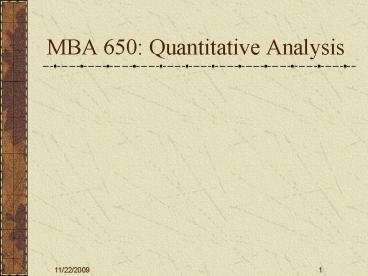MBA 650: Quantitative Analysis - PowerPoint PPT Presentation
MBA 650: Quantitative Analysis
Bay Area Bakery. Assumptions: A linear relationship between time and demand ... Use NW corner rule or Vogel's approximation method. 2. Determine entering variable ... – PowerPoint PPT presentation
Title: MBA 650: Quantitative Analysis
1
MBA 650 Quantitative Analysis
2
Bay Area Bakery
- Assumptions
- A linear relationship between time and demand
- Prices and costs remain constant over time
- Options
- Do nothing (capacity 6500 Cwt.)
- Build San Jose (capacity 6500 1200 Cwt.)
- Lease San Jose (capacity 6500 700 Cwt.)
- Expand Richmond (capacity 6500 500 to 1000
Cwt. in increments of 100 Cwt.)
3
Bay Area Bakery Suggested Financial Analysis
(Ignore Depreciation)
4
Transportation Problem
- Special structure all aij are 1 or 0
- Artificial variables none
- Input
- Si supply at source i
- Dj demand at destination j
- Cij unit transportation cost between source i
and destination j - Output
- xij amount shipped from source i to destination
j - z total cost
5
Transportation ProblemLP Formulation
- Min z Smi1Snj1 cij xij
- m represents rows n represents columns
- No. of decision variables m n
- St Smi1 xij gt Dj, j 1, 2, . ,n
- Snj1 xij lt Si, i 1, 2, . ,m
- No. of constraints m n
- xij gt 0
- aij 1 or 0
- This gives the model a computational advantage
over the simplex method
6
Transportation Problem3-Step Solution Procedure
- 1. Determine initial, feasible solution
- Use NW corner rule or Vogels approximation
method - 2. Determine entering variable
- 3. Determine leaving variable
7
TP Solution Procedure Step 2
- 2. Determine entering variable
- i. For BASIC vars ui vj cij
- ii. For NONBASIC vars c-barij ui vj cij
- MIN problem most positive c-barij enters
- MAX problem most negative c-barij enters
- iii. If all c-barij lt 0 (MIN problem) or gt 0 (MAX
problem), STOP! - Iv. If not, go to STEP 3!
8
TP Solution Procedure Step 3
- 3. Determine leaving variable
- i. Construct closed loop
- Start and end with entering var
- Use only BASIC vars to turn corners
- ii. Add units to entering var until a BASIC var
is driven to zero - iii. The leaving var is the BASIC var driven to
zero first - iv. Calculate new Z
- v. Return to STEP 2!
PowerShow.com is a leading presentation sharing website. It has millions of presentations already uploaded and available with 1,000s more being uploaded by its users every day. Whatever your area of interest, here you’ll be able to find and view presentations you’ll love and possibly download. And, best of all, it is completely free and easy to use.
You might even have a presentation you’d like to share with others. If so, just upload it to PowerShow.com. We’ll convert it to an HTML5 slideshow that includes all the media types you’ve already added: audio, video, music, pictures, animations and transition effects. Then you can share it with your target audience as well as PowerShow.com’s millions of monthly visitors. And, again, it’s all free.
About the Developers
PowerShow.com is brought to you by CrystalGraphics, the award-winning developer and market-leading publisher of rich-media enhancement products for presentations. Our product offerings include millions of PowerPoint templates, diagrams, animated 3D characters and more.































